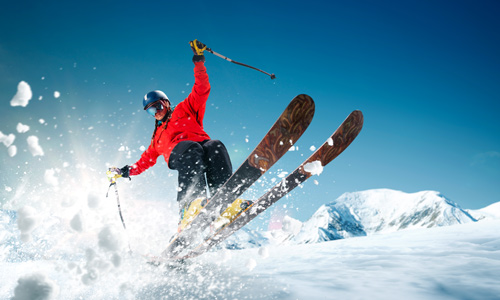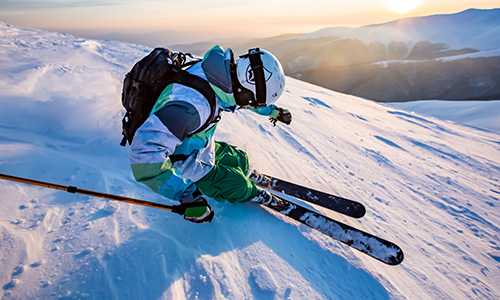How to avoid skiing injuries
- Overview
The feel of the cold, crisp mountain air and the thrill of skiing draws many people to the slopes each year, but injuries are not uncommon. A few precautionary measures should be all it takes to ward off the most common ski injuries, allowing you to most of your holiday.
Common ski injuries

Knee injuries
The most common injuries are to the knee, due to the twisting motion that can occur during falls or from direct trauma to the knee when skiing. The medial collateral ligament (MCL) and anterior cruciate ligaments (ACL), which run on the inside of the knee and provide stability to the joint, are commonly injured during skiing.
Upper limb injuries
Dislocated shoulders are another common injury resulting from a fall. The ligaments and the joint capsule become stretched during the trauma, which results in the ball of the shoulder joint coming out of the socket.
Thumb injuries
Skiers' thumb can occur when the ski pole causes the ligament on the inside of the thumb to become stretched or torn.
Ski training and preparation
Like all sports, injuries are much less likely to take place if your general level of fitness is high. For skiing, improving your strength and stamina can go a long way to preventing injuries. You could try running, cycling or swimming to build your cardiovascular fitness or challenge yourself with our pre-ski workout.
Build strength
The muscles in the legs aren't accustomed to the forces placed on them during skiing so many injuries happen at the start of a holiday. It may be seen as ‘unlucky’, but skiers whose muscles aren't ready for the extra exertion of skiing are unable to control their leg position or withstand changes in force placed on the knees from a minor bump or twist.
Exercises such as sitting against the door in a squat position can help, but a simple 20-minute plyometric (jump training) programme every other day for as little as two weeks before your trip might be more effective.
Warm up - (it's science)
Set bindings correctly
Your ski binding release (DIN setting) being too tight is a common cause of ACL and MCL injury. This setting allows your boot to come out of the ski when you twist at low speed, where there's highest risk of injury, and at high speed falls. While premature release of the ski is a consideration, it is a misconception that as you become a better skier you need your release binding on a much tighter setting.
Brace yourself
Knee braces can be an excellent way of reducing injury in combination with training in the run up to your ski trip. There are many different types of braces that can be used, from simple hinge braces through to advanced support for people who have previously suffered a specific injury.
If you’re going to fall, learn how to do it right
For most, falling while skiing is inevitable, but you can protect yourself from injury by falling correctly. Don’t panic and splay your arms and legs which leaves you vulnerable to both upper and lower limb injuries. If you know you are going to fall, let it happen. A purposeful fall is safer. Try if possible, to roll with the fall or flop onto your side and skid to a stop.
If you find yourself sliding down a steep slope, try and keep your legs straight and raise your skis off the ground so as not to dig them into the snow and twist your knee. Proper ski lessons will teach you to stop, fall and control your speed.
Good sense ways to avoid ski injury

Most knee injuries are caused by skiing on slopes above your level of competency. Whilst striving for the black runs is the goal of most skiiers, remember that the secret to avoiding injuries is knowing your limits. Sharp, out of control turns can cause havoc with the knees' anatomy so master the level you’re at before taking on more challenging routes. The same goes for tricky conditions, icy slopes can make even the easiest of pistes more challenging to take it easy when the snow isn’t powder.
Ski off-peak
The busier the slope, the more vulnerable you are to collisions. Enjoy the freedom of quieter slopes for a safer ride.
Avoid alcohol at lunch
It goes without saying that alcohol and skiing make a dodgy cocktail. Alcohol compromises your concentration and reaction speeds, while lowering your inhibitions. Drink and ski at your peril.
Avoid that ‘one last run’
Leave the slopes on a high, rather than when you’re exhausted, to avoid injury.
Take the lift at the end of the day
Icy, patchy slopes, crowded with tired skiers are a hot bed for injury. Be cool and take the lift.
Seek advice immediately after an injury
Resist the temptation to plough on after an injury. Ski-clinics are well-versed in treating common injuries: heeding their expert advice will help you last the season. Take a look at our ski trip injury first aid guide, and follow-up with an appointment to see your physio when you get home.
Skiing holidays can be expensive and having your ski time cut short by injury can be frustrating and disappointing. Following this advice can help you enjoy your skiing and make your holiday one to remember rather than one to forget.'
Last updated Friday 3 January 2020
First published on Monday 11 February 2019

